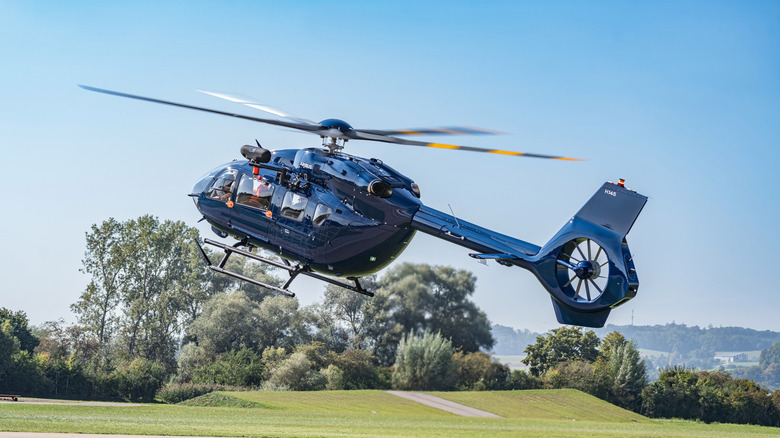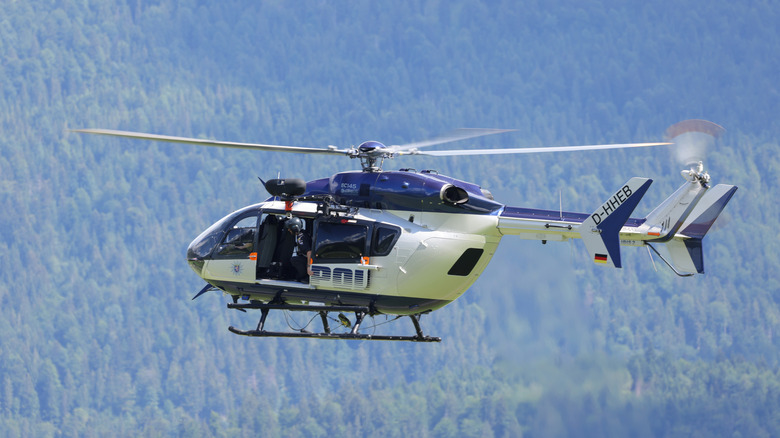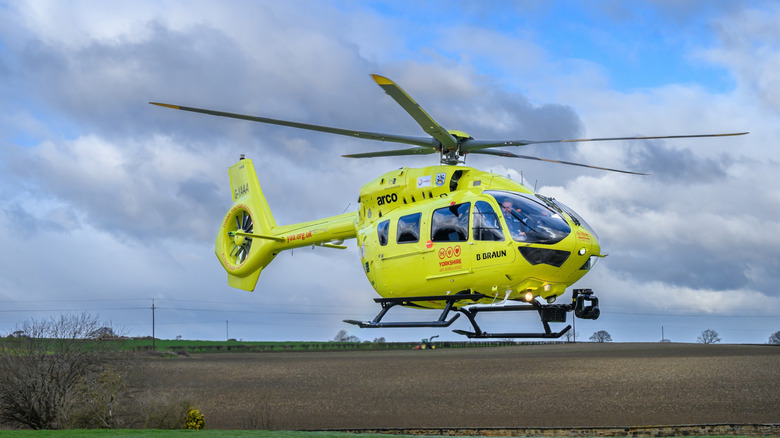
Unless you're a serious aviation geek who can name the world's fastest helicopters without skipping a beat, there's a good chance you've never heard of the Airbus H145 or the Eurocopter EC145. However, you may have seen them in action without even knowing. Many air ambulances rescuing patients are often H145s or EC145s. As one of the most widely used helicopters for air ambulance services in the U.S., the H145 and the EC145 have built a solid reputation over the years while helping save thousands
of lives.
These helicopters have proven their versatility, attracting the attention of law enforcement agencies, fire services, and oil companies. In fact, Airbus — the current manufacturer of the H145 — even makes separate military and corporate iterations of the helicopter (like this super luxurious Airbus ACH-160) with slightly different names. Now, the one thing you may have noticed about the Airbus H145 and Eurocopter EC145 — is that they have eerily similar-sounding names but seemingly different manufacturers. There's actually a logical explanation for this.
As it turns out, Eurocopter, the company that made the original EC145, was a European helicopter manufacturer owned by the same company that also owns Airbus, the famed plane maker. In 2014, following a corporate restructuring, the Eurocopter name was dropped in favor of "Airbus Helicopters." This was a move to align the company's helicopter business with its parent company, the Airbus Group. Along with the new name came a new naming system: the familiar "EC" prefix for Eurocopter models was replaced by an "H" for Airbus Helicopters. This is how the EC145 became the H145.
So, is it safe to assume that the H145 is just a renamed EC145? Well, it's not that simple, either.
Read more: 10 Of The Fastest Civilian Helicopters, Ranked By Top Speed
How The Eurocopter EC145 Became The Airbus H145

During the time Airbus underwent the aforementioned corporate restructuring process, Eurocopter was developing an upgraded version of the EC145. The company called it the EC145 T2. This version came with a lot of upgrades over the standard EC145 model. It had more powerful engines and a redesigned, fully enclosed tail rotor. It also featured more advanced avionics, something that the aged EC145 desperately needed. Another major improvement on the T2 model was its lower noise levels, which made life easier not only for the operating crew but also for those who had to work in close proximity to the helicopter.
Despite these major changes, the helicopter retained the tried-and-tested design template of its successful predecessor. By the time Eurocopter officially became Airbus Helicopters and adopted the "H" naming convention, the T2 was ready for production. Rather than launch an entirely new model, Airbus simply rebranded the EC145 T2 as the H145 — making it the natural continuation of the EC145 family, but under a new corporate identity and with modern capabilities baked in. So while the H145 may be thought of as a renamed EC145, it's technically the T2 variant.
The Key Differences Between The EC145 And The H145

Now that we have established that the H145 helicopter is not quite the same as the original EC145, let's delve into the juicier details of how different it really is. To begin with, the H145 features upgraded Turbomeca Arriel 2E engines that offer more power, better fuel efficiency, with lower emissions. The EC145 uses older Turbomeca Arriel 1E2 engines. The newer engines of the H145 generally offer better single-engine performance, a slightly higher maximum takeoff weight (MTOW), and more payload capacity than the EC145.
The biggest visual change between the two helicopters is the tail rotor design. While the EC145's tail rotors were exposed, the H145 uses an enclosed tail rotor design known as a Fenestron design in aviation parlance. The enclosed design makes the H145 inherently safer to operate in the presence of ground crew. It also contributes to the lower overall noise levels of the helicopter.
Considering the EC145 was designed in the 1990s, and began operating in the early 2000s, it featured an older generation avionics suite from that era, which, despite periodic upgrades, was in need of a revamp. The H145 delivers precisely that thanks to its modern avionics suite from Helionix. This advanced suite brings several key capabilities like a 4-axis autopilot system, modern digital cockpit displays that enhance readability and functionality, and significantly improved situational awareness for pilots, which contributes to an overall reduction in pilot workload.
Now that you know a bit more about the EC145 and H145, it's easier to understand why they hold an important place in emergency medical services and public safety roles. While they may not be as widely recognized as some military models, their life-saving contributions are hard to overlook.
Want the latest in tech and auto trends? Subscribe to our free newsletter for the latest headlines, expert guides, and how-to tips, one email at a time.
Read the original article on SlashGear.












